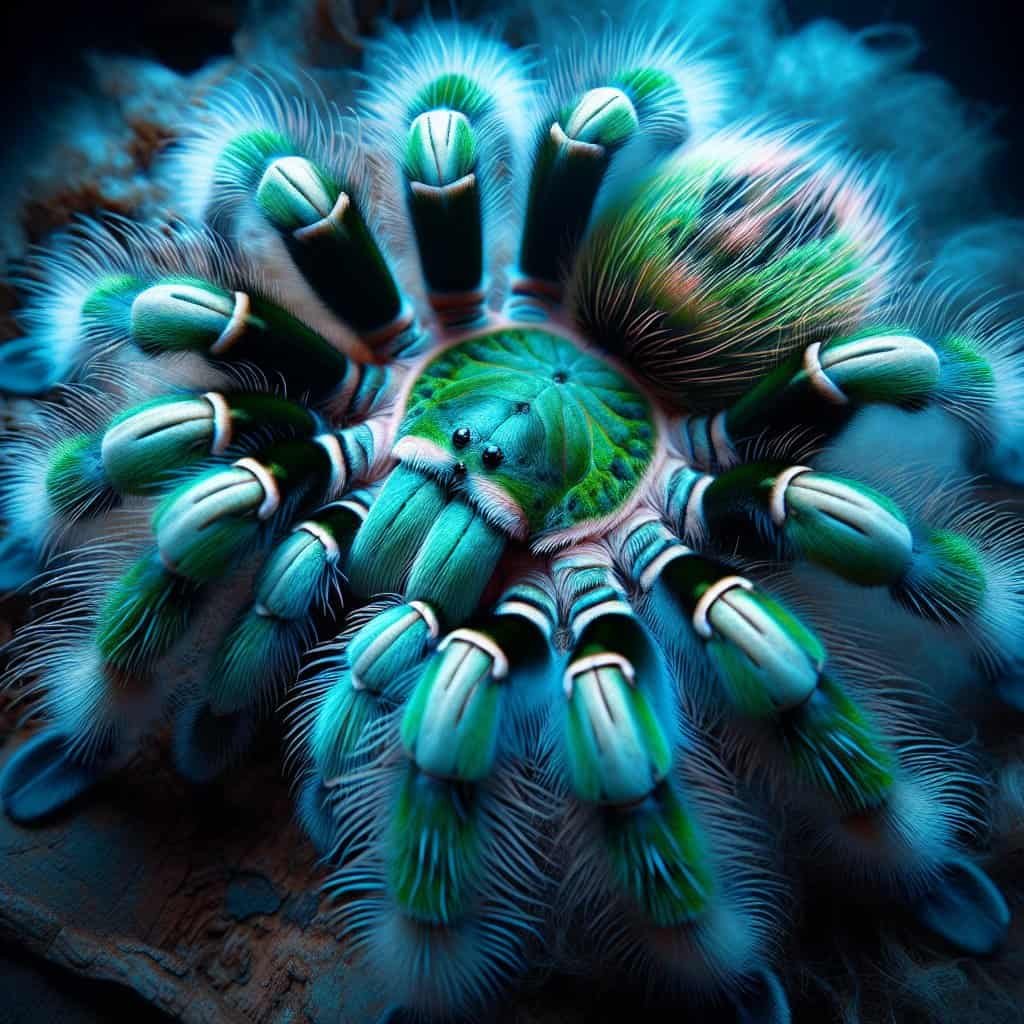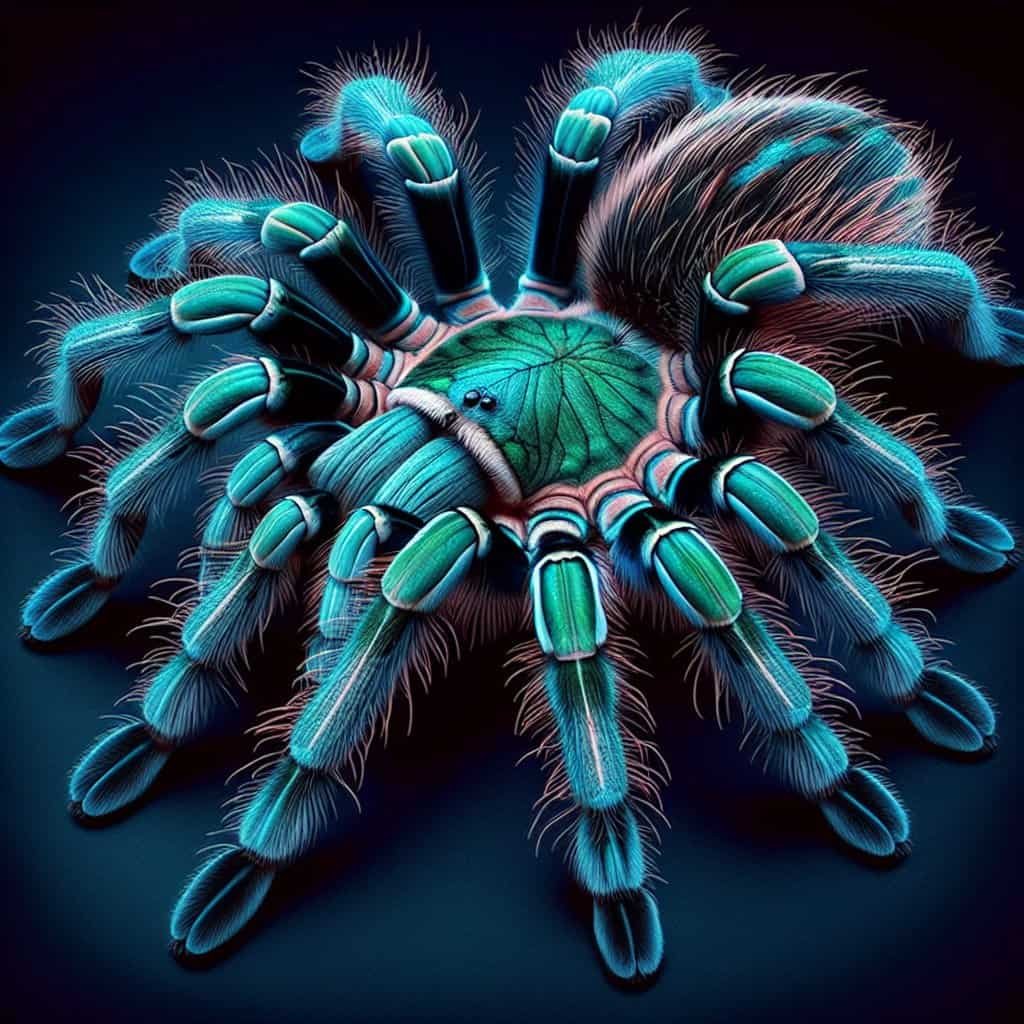Let’s take a moment to marvel at the captivating beauty of the Greenbottle Blue Tarantula. With its vibrant and striking blue coloration, this arachnid certainly stands out from the crowd. But what makes this species truly fascinating are its unique characteristics. From its intricate patterns to its extraordinary agility, the Greenbottle Blue Tarantula possesses a charm that cannot be denied. Now, let’s embark on a journey to discover not only its physical attributes but also its native habitat, painting a vivid picture of this remarkable creature.
Characteristics of the Greenbottle Blue Tarantula
Physical Appearance
The Greenbottle Blue Tarantula is known for its stunning and vibrant colors, making it one of the most visually striking tarantula species. Its carapace, which is the shield covering its body, is a beautiful metallic blue-green hue, hence the name “Greenbottle Blue.” The abdomen is predominantly blue with distinct orange hairs and patches of red, creating a fiery appearance. The legs are covered in blue hairs, which further adds to its overall eye-catching beauty. This tarantula has a leg span of approximately six inches, making it a medium-sized species in the tarantula world.
Behavior and Habitat
The Greenbottle Blue Tarantula is primarily found in the harsh deserts of northern Venezuela, specifically in the Paraguana Peninsula. Despite its vibrant appearance, this tarantula is known for its skittish nature and defensive behavior. When threatened, it may flick its hairs as a defense mechanism, which can cause irritation if they come into contact with the eyes or skin. This species is also an avid digger, and in the wild, it constructs elaborate burrows lined with silk for protection against predators and to regulate its body temperature.
Lifespan and Size
On average, the Greenbottle Blue Tarantula has a lifespan of approximately 10 to 12 years. However, with proper care, some individuals have been known to live up to 15 years or more. As mentioned earlier, it has a leg span of around six inches, with males typically being slightly smaller than females. Male Greenbottle Blues reach maturity at around four to five years of age, while females take longer, maturing at around five to six years of age.
Native Habitat of the Greenbottle Blue Tarantula
Geographical Range
The Greenbottle Blue Tarantula is endemic to the Paraguana Peninsula in northern Venezuela, which is located on the northeastern coastline of South America. This region is characterized by its arid and desert-like climate, with sparse vegetation and sand dunes dominating the landscape. The combination of these unique environmental factors provides the perfect conditions for the Greenbottle Blue Tarantula to thrive.
Natural Environment
Within its native habitat, the Greenbottle Blue Tarantula is found in dry and scrubby areas, often inhabiting abandoned rodent burrows or creating its own intricate burrows. The arid climate and sandy terrain create a challenging environment for many species, but the Greenbottle Blue has adapted to these conditions remarkably well. It has developed specific behaviors and physical characteristics that allow it to navigate the harsh desert landscape successfully.

Distribution and Conservation
Populations and Endangered Status
While the Greenbottle Blue Tarantula remains relatively abundant within its limited geographic range on the Paraguana Peninsula, there are concerns about the potential impact of habitat destruction and collection for the pet trade on its population. The exact number of individuals in the wild is unknown due to its elusive nature and the difficulty in conducting comprehensive population studies of such an elusive species.
Illegal Trade and Conservation Efforts
Unfortunately, the Greenbottle Blue Tarantula has become a popular target for illegal wildlife trafficking due to its stunning appearance and rarity in captivity. The illegal pet trade poses a significant threat to its population, as unregulated collection can deplete its numbers in the wild. To combat this issue, ongoing conservation efforts focus on raising awareness about the importance of responsible pet ownership and supporting initiatives that promote captive breeding to reduce the demand for wild-caught specimens.
Unique Adaptations
Vibrant Colors and Camouflage
The vibrant colors of the Greenbottle Blue Tarantula serve two essential purposes in its natural environment. Firstly, the blue-green carapace and blue-legged hairs provide effective camouflage, allowing the tarantula to blend in with the sandy desert terrain. This helps it avoid predators and enhances its hunting success. Secondly, the bright orange and red hairs on its abdomen act as a warning sign to potential threats, signaling its venomous capabilities and deterring predators from attacking.
Spinnerets and Web-building
Like all tarantulas, the Greenbottle Blue possesses silk-producing organs called spinnerets on its abdomen. These spinnerets allow the tarantula to construct silk webs for various purposes, including creating a secure retreat within their burrows and capturing prey. Although the Greenbottle Blue is primarily a terrestrial species that relies on hunting techniques rather than web-building for food, its spinnerets play a crucial role in reinforcing the burrow entrance and ensuring its structural integrity.

Species Variation and Taxonomy
Genus Chromatopelma
The Greenbottle Blue Tarantula belongs to the genus Chromatopelma, which includes several species with similar physical characteristics and habits. This genus is known for its vibrant colors and intriguing behaviors, making it a favorite among tarantula enthusiasts. However, it is essential to note that the Greenbottle Blue is the only species within the Chromatopelma genus, making it truly unique and distinctive.
Other Subspecies and Morphs
While there are no recognized subspecies of the Greenbottle Blue Tarantula, variations in coloration and patterns can occur within individual populations. These variations are often referred to as “morphs” and are highly sought after by tarantula collectors and enthusiasts. Morphs can display subtle differences in color intensity, leg striping, or hair distribution, adding another layer of intrigue to an already captivating species.
Tarantula Keeping and Care
Suitable Enclosures and Environment
When keeping the Greenbottle Blue Tarantula as a pet, it is essential to provide an enclosure that mimics its natural habitat as closely as possible. A glass or plastic terrarium with ample floor space and moderate height is ideal. The substrate should consist of a sandy mix that allows the tarantula to create burrows, and the addition of rocks and bark for climbing and hiding is also recommended. Temperature and humidity levels should be maintained according to the tarantula’s needs, with a particular focus on providing a dry environment with good ventilation.
Feeding and Handling
The Greenbottle Blue Tarantula is primarily a carnivorous species, feeding on a diet of small insects and occasionally small vertebrates in the wild. In captivity, a varied diet consisting of live insects such as crickets, mealworms, and roaches should be provided regularly. It is important to avoid overfeeding and to remove any uneaten prey to maintain a clean and hygienic enclosure. As for handling, it is generally recommended to limit direct contact with the tarantula, as their skittish nature and propensity for flicking hairs can cause discomfort and potential harm to both the tarantula and handler.

Breeding and Reproduction
Mating Rituals and Courtship
The mating rituals of the Greenbottle Blue Tarantula are a fascinating display of courtship behaviors. When males reach sexual maturity, they embark on a quest to find a receptive female. The male employs a combination of leg tapping and intricate movements to communicate his intentions to the female gently. If successful, the female will respond positively, allowing the male to approach and mate.
Egg-laying and Spiderlings
After a successful mating, the female Greenbottle Blue Tarantula will eventually lay an egg sac containing fertilized eggs. This process typically takes several weeks. The female will fiercely guard the egg sac and provide care until the spiderlings hatch. Once hatched, the spiderlings are entirely independent and will disperse on their own, beginning their individual journeys of growth and survival.
Interactions with Humans
Fear and Misconceptions
Tarantulas, including the Greenbottle Blue, often evoke fear and misconceptions due to their appearance and reputation. While they do possess venom and can bite if threatened, their venom is generally considered to be relatively mild compared to other spider species. Additionally, the Greenbottle Blue is known for its skittish behavior and preference for avoiding conflict rather than engaging in aggression. With proper handling and care, they can make fascinating and captivating pets.
Importance in Research and Education
Tarantulas, including the Greenbottle Blue, play an essential role in research and education. They offer valuable insights into the fields of ecology, anatomy, and behavior of arachnids. Furthermore, their captivating appearance and unique adaptations serve as a gateway for educating the public about the importance of conserving biodiversity and appreciating the intricate wonders of the natural world.

Other Notable Tarantula Species
Brazilian Pink Tarantula
The Brazilian Pink Tarantula, also known as the Pink Bloom Tarantula, is a stunning species that garners attention for its striking pink coloration. It is native to the Amazon rainforest in Brazil and is a highly sought-after species in the pet trade.
Mexican Redknee Tarantula
The Mexican Redknee Tarantula is another popular and widely recognized tarantula species. As the name implies, it boasts vibrant red-orange knees. It is native to parts of Mexico, primarily Guerrero and Colima states, and is known for its docile temperament and manageable size.
Conclusion
In conclusion, the Greenbottle Blue Tarantula exhibits a unique set of characteristics that make it a truly striking species. With its vibrant colors, intricate behaviors, and impressive adaptability, it stands out among its tarantula counterparts. Native to the arid regions of the Paraguana Peninsula in Venezuela, this tarantula has learned to thrive in a challenging environment. While there are concerns about its conservation status and the impact of illegal trade, efforts to promote responsible pet ownership and captive breeding offer hope for the future. By appreciating and understanding this captivating species, we can contribute to its conservation and ensure its continued presence for generations to come.

